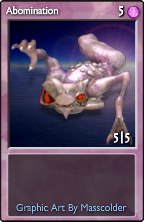Why are high quantas cards not popular?
i have been making 15 quantas dragons, but none of them are popular.
I think mono decks can be improved vastly compared to overpowered rainbows decks
if we can introduce more super high quantas cards.
The thing is, your dragons (I believe the only two are the fracture one and the ice one) have either OP abilities or relatively situational abilities, fracture and ice respectively.
It's not about the cost really, it's more of the ability. Ability and stats should determine cost, not the other way around (or no correlation at all, that's bad too)
I'm going to post a bit more of a definitive response.
Compare these two card:


If you look at these cards, you'll notice that Abomination is simply half a purple dragon. Or, that purple dragon is double an abomination - two abominations.
Now, it's a somewhat reasonable assumption, that, if abomination is balanced, then doubling (nearly) all of its stats is also balanced - This can be called scaling. When someone asks you to scale the card down, they're simply asking you to make the card smaller overall, but keep the proportions of ATK/HP/Cost roughly the same. This will work for most card games - taking magic, a 2/2 creature for 2 mana is balanced, and so is a 4/4 creature for 4 mana. A 6/6 for 6 mana tends to be somewhat lackluster, but not "bad" - I'd take a 6/6 for 6.
This is not true for elements, or at least much less true. Scaling a card gets out of hand quickly.
Using abomination and purple dragon, what if we made a card that was a scaled purple dragon?

^^^ I believe this to be too powerful.
Let's examine the quanta system for a minute. You play pillars, and they give you quanta at the end of you turn. You can use quanta to cast spells. This sounds similar enough to magic, as of now, where scaling works - You play lands, and then "tap" those lands to produce mana to cast spells.
Here is the huge difference:
In elements, you can play unlimited pillars a turn.
In magic, you can play only one land a turn.
What does this change? Everything.
There is no way to predict when a card is going to come out: When you see massive giant finisher cards in magic, it's assumed that they will be played late in the game, and they are, unless you try to cheat it out. There is no true "early game card" or "late game card" in elements - a way of stopping the late game cards from trouncing everything doesn't exist in elements. And if it does, it does not do its job well enough.
Because you can store quanta, it is feasible to cast any card that costs over 20 quanta on your fourth turn, unupped, and still have a lot of quanta left over for defence. Unupped.
Upped, It should be doable on your third turn. Elements does not scale correctly; It does not take double the amount of time to cast something that costs double the cost of another card in elements, which makes scaling a card really difficult.
Then we have the problem that most cards in elements are in the most scaled down form they can be in - thier most brute form, if you will. As a result, scaling up cards makes them look and feel incredibly powerful in comparison, which clouds judgement.
All these factors rolled in together makes making high-cost cards actually hard to do - I've only ever designed one card with double-digit numbers off of the top of my head, and have seen very few cards with such high costs that I actually like.
As for cards being broken due to high costs, all you have to do is look at fractal, a card that a good portion of people consider overpowered. And I don't recall light stalls struggling to cast miracles quickly enough too often.

